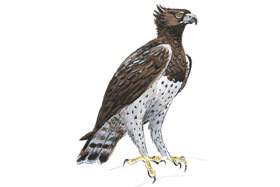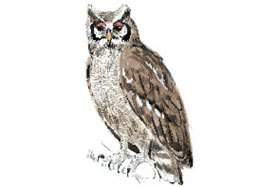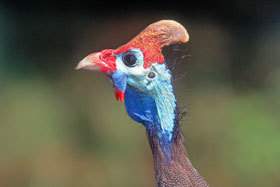
Birding Map of Kruger Park Olifants and Letaba Area
- Phalaborwa Gate to Letaba
- Olifants to Letaba
- Engelhard and Mingerhout Dams
- Letaba to Mopani
- Letaba to Shingwedzi
- Around Olifants
The Magpie Shrike* is fairly common along this road. Stop on the Letaba river bridge. (See Letaba River Bridge above).
North of Letaba Bridge, the mopaneveld alternates between its tree and shrub forms with large pockets of grassland opening up, particularly to the east of the road. This area is known for raptor sightings as well as for the larger savanna grassbirds such as the Common Ostrich*, Secretarybird and Kori Bustard. Kruger's ostriches are indigenous, unlike those found in the Karoo today, which descend from ostriches imported from Kenya during the late 19th and early 20th centuries.
Legendary game ranger Harry Wolhuter on the Kori Bustard: 'I have always pot-boiled them first and then poured off the first water as they have rather a rank flavour. When properly cooked, however, the slices off the breast are very tasty.'
Twisappel Water Hole is a dam surrounded by a large vlei area and there is usually bird activity on both sides of the road. Pied Kingfishers, Saddle-billed Stork, Black Crake and African Crake can be seen in these marshlands. This is the most reliable water source along the Letaba-Mopani road so it is a favourite drinking hole for buffalo, elephant and waterbuck.
Birding in the mopaneveld is best along the rivers. For this reason the Tsendze Loop (S48) is a recommended detour as it follows the Tsendze River for approximately 10 kilometres, offering several views over the river. Look out here for the African Openbill*.
A 'lifer' for the authors along the Tsendze River came in the form of the Lesser Yellowlegs that was seen on a sandbank close to a Wood Sandpiper with which it can be confused. The Lesser Yellowlegs breeds on the other side of the Atlantic in western Alaska and Canada and has only rarely been seen in southern Africa. The riverine trees are often host to raptors looking out over the river and shrubveld for prey. The Lesser Spotted Eagle is one of the more regular sightings here - it has diagnostic 'stove-pipe' legs and exhibits a flash of white wing as it takes off from its woodland perch.
Back on the main road, Middelvlei is a good place to brush up on lark identification - the Rufous-naped, Red-capped and Sabota Larks are often busy in the grassland around the windmill.
From the junction with the Phalaborwa Road (H1-4), the birdlife becomes more active the closer one is to Mopani Camp. The road follows the Tsendze River and there are good viewing spots at Confluence and Mooiplaas Picnic Spot. Mooiplaas staff claim that the Verreaux's Eagle-Owl nests nearby and can sometimes be seen on overcast days.
At the turn-off to Mopani Camp off the H1-6 there is a small patch of wetland where Burchell's Coucal is often seen, moving around in the long grass with an almost deliberate clumsiness. In summer there are often a variety of cuckoos here as well.
Giriyondo Border Post is open in summer (1 October - 31 March from 0800-16h00) and in winter (1 April - 30 September from 08h00-15h00). Currently only 4x4s are allowed across the border, and no vehicles that weigh over four tons. No commercial traffic is allowed through Giriyondo.
Giriyondo Border Post Road (H15)
 The Giriyondo Border Post is the most accessible entry point into the Limpopo National Park in Mozambique. It is 36km from Letaba camp which is approximately an hour's leisurely drive. In summer after good rains, Black Coucal are sometimes seen in the grass at the junction, which is also a good area for Tsessebe. The Giriyondo Road (H15) goes through very flat shrub Mopane with wide open grasslands and even grazing. The woodlands become denser around the Makhadzi River crossing.
The Giriyondo Border Post is the most accessible entry point into the Limpopo National Park in Mozambique. It is 36km from Letaba camp which is approximately an hour's leisurely drive. In summer after good rains, Black Coucal are sometimes seen in the grass at the junction, which is also a good area for Tsessebe. The Giriyondo Road (H15) goes through very flat shrub Mopane with wide open grasslands and even grazing. The woodlands become denser around the Makhadzi River crossing.
The road from Makhadzi to the border has lots of humps to prevent speeding through the flat grasslands. The road cuts through the Lebombo shortly before the border post. There is little game in the area, and those animals that are seen appear skittish, possibly due to cross-border poaching in the past.
 Guineafowl and Whiskey
Guineafowl and Whiskey
Makhadzi Picnic Site has a fascinating storyboard about a far-flung outpost of Steinaecker's Horse. The remains of Fort Mpisane near Bushbuckridge (just outside Kruger) were rediscovered in 1996 and the subsequent archaeological dig has shed light on the daily lives of Steinaecker's Horse and the Shangaan-speaking communities they interacted with.
The regiment's main job was to patrol the Mozambican border to prevent any contact between the Boers and any sympathisers across the Portuguese colonial border. To this end, they had a series of encampments along the Lebombo from Komatipoort to the Letaba River area. Fort Mpisane, near Bushbuckridge, was their northernmost camp. They shared it with the local Shangaan-speaking Chief Mpisane who ruled the communities that lived in central Kruger.
Archaeology confirms that Steinaecker's Horse spent a lot of time hunting for sport and to supplement their rations of tinned bully beef, tinned peaches, hard biscuits, pickles and whiskey. Guineafowl bones and shotgun cartridges have been excavated from the site, as well as the remains of Worcestershire Sauce bottles made by Holbrook and Co. No doubt this was washed down, as the educational display notes, with a 'large and varied amount of alcoholic and liquid refreshment'.
Whether or not this lifestyle had anything to do with their battle record is open to speculation. Their only major battle was the Battle for Fort Mpisane in August 1901. Steinaecker's Horse surrendered without too much of a fight to a Boer Commando that launched a surprise attack on them.
The battle had no effect on the outcome of the war, which the British won shortly afterwards. After the disbanding of Steinaeckers' Horse in 1904, several of its black and white troops went on to become game rangers in the Kruger Park because of their intimate knowledge of the area and the bush - among them was Harry Wolhuter. The regimental leader, Colonel Ludwig Steinaecker eventually became insane and committed suicide.

